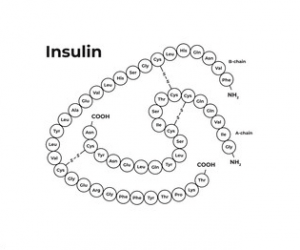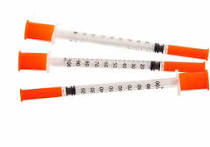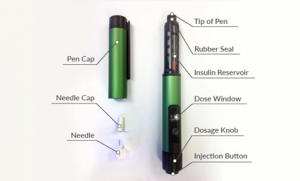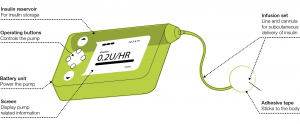Exogenous Insulin
Insulin is hormone that is used as a medicine to treat elevated blood glucose levels in number of conditions including type 1 diabetes, type 2 diabetes, gestational diabetes, and complications of diabetes such as ketoacidosis and hyperosmolar hyperglycaemic state.

Since insulin is a protein, it must be given as an injection, usually subcutaneously, but occasionally can be injected into a vein or muscle. Insulin can be delivered via a syringe, insulin pen or insulin pump depending on the preference of the person with diabetes.
Syringe

Insulin Pen

Insulin Pump

In an individual that does not have diabetes insulin is produced in the islet cells of the pancreas. This helps regulate glucose (the body’s primary energy source) from carbohydrates where it then enters the bloodstream. Insulin helps glucose enter the cells where it can be used as energy.
Insulin also helps store excess glucose in the liver (as glycogen). When insulin levels are low the liver will release glycogen in the form of glucose. Between these two steps endogenous insulin allows glucose levels to be kept within a narrow range.
The goal of insulin therapy is to keep an individual with diabetes (no matter what type!) well by keeping blood glucose levels in a healthy range. The heathy glucose level range for each individual depends on many factors including age, how long the person has had diabetes, other health conditions and medications that cause hypoglycaemia (person centred care).
While there are many different types of insulin, the two main roles of therapy are to keep an individual’s glucose levels stable when a person is not eating (when the liver is releasing glucose from its glycogen stores) with long, ultralong or intermediate acting insulin and to maintain glucose levels after eating, using short or rapid acting insulin.
Insulin also helps store excess glucose in the liver (as glycogen). When insulin levels are low the liver will release glycogen in the form of glucose. Between these two steps endogenous insulin allows glucose levels to be kept within a narrow range.
The goal of insulin therapy is to keep an individual with diabetes (no matter what type!) well by keeping blood glucose levels in a healthy range. The heathy glucose level range for each individual depends on many factors including age, how long the person has had diabetes, other health conditions and medications that cause hypoglycaemia (person centred care).
While there are many different types of insulin, the two main roles of therapy are to keep an individual’s glucose levels stable when a person is not eating (when the liver is releasing glucose from its glycogen stores) with long, ultralong or intermediate acting insulin and to maintain glucose levels after eating, using short or rapid acting insulin.
Formulations:
- Ultralong, long or intermediate acting insulin
- Short acting or ultrashort acting insulin
- Premixed insulin
- Lispro 25%/lispro protamine 75% (Humalog MX 25)
- Lispro 50%/lispro protamine 50% (Humalog Mix 50)
- Insulin aspart 30%/insulin aspart protamine 70% (NovoMix 30)
- Neutral 30%/isophane 70% (Humulin 30/70, Mixtard 30/70)
- Neutral 50%/isophane 50% (Mixtard 50/50)
- Coformulation insulin
- Ryzodeg (degludec 70% and insulin aspart 30%) is the first co-formulation insulin. This means the actions of the individual insulins are independent of each other.
